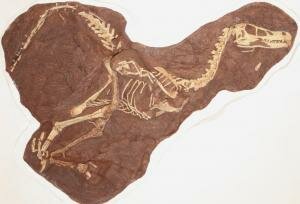New Species Of Raptor Dinosaur In Inner Mongolia
A new species of dinosaur, a relative of the famous Velociraptor, has been discovered in Inner Mongolia by two PhD students.
The exceptionally well preserved dinosaur, named Linheraptor exquisitus, is the first near complete skeleton of its kind to be found in the Gobi desert since 1972, and will help scientists work out the appearance of other closely related dinosaur species.
Linheraptor is in the Dromaeosauridae family of the carnivorous theropod dinosaurs and lived during the Late Cretaceous period. In addition to Linheraptor and Velociraptor, theropod dinosaurs include charismatic meat-eaters like Tyrannosaurus rex and modern birds.
The two PhD students, Michael Pittman from UCL (University College London) and Jonah Choiniere from George Washington University (GWU), found the dinosaur sticking out of a cliff face during a field project in Inner Mongolia, China. Their research is published online in the journal Zootaxa.
"Jonah saw a claw protruding from the cliff face. He carefully removed it and handed it to me. We went through its features silently but he wanted my identification first. I told him it was from a carnivorous dinosaur and when he agreed I'm surprised nobody in London heard us shouting," said Michael Pittman, a PhD student in the UCL Department of Earth Sciences who was the co-discoverer of the dinosaur.
"I've always wanted to discover a dinosaur since I was a kid, and I've never given up on the idea. It was amazing that my first discovery was from a Velociraptor relative. My thesis is on the evolution and biomechanics of dinosaur tails but the carnivorous dinosaurs are my favourite and my specialty," he added.
At approximately 2.5 metres long and 25 kilograms, the researchers believe Linheraptor would have been a fast, agile predator that preyed on small horned dinosaurs related to Triceratops. Like other dromaeosaurids, it possessed a large "killing claw" on the foot, which may have been used to capture prey. Within the Dromaeosauridae family, Linheraptor is most closely related to another recently discovered species Tsaagan mangas.

"A photograph of the entire Linheraptor exquisitus skeleton. (Credit: Courtesy of Dr. David W. E. Hone, Institute of Vertebrate Palaeontology & Palaeoanthropology, Beijing)"
Source: University College London
|